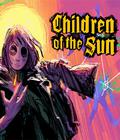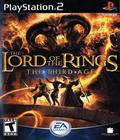Buy 'LOTR: The Third Age':
Xbox | GameCube | GBA | PlayStation 2
If someone walked in on you just after you'd started up Third Age, they could be forgiven for thinking they were looking at one of the movie DVDs for the first ten or so minutes. The game opens with a lengthy re-edited sequence of film from the movies explaining the back history of the One Ring and some of the people connected with it, with narration coming out of the ever-impressive vocal cords of Ian McKellen reprising his role as Gandalf. Eventually the game turns over control of Berethor the Gondorian Scout to the player for a few minutes, for a brief warm-up battle. After the battle, a fairly brief cutscene plays, and you are invited to watch more scenes from the movie, in which Gandalf explains who Berethor is and what he's doing there.
You might be starting to notice a minor problem with the storytelling here.
Berethor, our hero of sorts, comes off as kind of a Gondorian Arthur Dent from The Hitchhiker's Guide to the Galaxy. His companions (at first the Elf Idrial, followed quickly by Ranger Elegost and Dwarf Hadhod, with a pair of latecomers joining up further on), are pretty much there just to drag him along briskly. Idrial in particular is good at this, for a while every other sentence she says to him is a varient of "Come along, Gondorian." Not only is the plot on rails, but your traveling companions built the railroad.
It is, at least, a scenic trip. From the hills and mountains of the west to the plains of Rohan and the walls of Helm's Deep, the area designers are obviously working straight from CGI from the film to bring you the environments of... uh, New Zealand, but we'll pretend it's Middle Earth. I'd venture to say this game has better fog than Silent Hill. The character models are detailed and items equipped show up right on their body, which is always a good, atmosphere-building touch. There are other things I could go on about, like the detailed and realistic fire effects and the near-perfect look of water sloshing in the rivers, but you're probably getting the idea. This is a pretty game.
In theory, Berethor is slogging through the glory and splendor of Middle Earth in his attempt to catch up with Boromir, whom you may recall as the grabby fellow who dies at the end of the first movie. This is the game's excuse for you to spend the first 33-and-1/3% of Third Age pursuing the Fellowship of the Ring by about a half-step behind. For the most part you'll be travelling the same territory, seeing the same sights, and stumbling upon moment after moment from the movie trilogy that Gandalf will narrate to you. Did I mention the sound? The sound is very well done. Plenty of ambient music from the film, the growls and roars sound like they're supposed to, and our principle characters don't come across as being stunt doubles trying to fill in a proper bit of voice acting. I'd like to single out Elegost's actor in particular, the man was having a ball with his lines and it bleeds through into the character, making him the lifeblood of the group.
There is also combat. That part is done fairly well.
Which is a good thing, because there certainly is a heck of a lot of it.
By now if you follow gaming circles at all you've probably seen the Penny Arcade strip that compares this game's combat system to Final Fantasy X. To say there is a certain resemblance is an understatement. If you have played FFX (and if you haven't by now, let me be the first to welcome you out of cryogenic suspension and give you greetings from the glorious World of Tomorrow), this will probably seem very new and very exciting. It's a turn-based battle system that moves along at a brisk clip, and allows you to swap party members in and out of battle at any time. It isn't very exciting, and it is indeed as strange as you would think to see snarling orcs and goblins politely line up opposite a ragtag band of warriors to take neat orderly swipes at each other. Still, for a game that places combat above all else, it's a functional system.
There are a couple of ways the game differs from Final Fantasy X's battle system. One is that your 'limit break' or 'overdrive' or 'whatever' meter is now a shared meter for the entire party. That's all right, no one in your party ever has unique super-special attacks to break out, those are all shared too. The other way is the skill system. Each time you successfully use a skill in battle, such as "Bow Attacks" or "Elemental Spirit Powers" or the like, you earn one point towards that power set. Each time you crest a certain number of points, say ten, you learn a new skill. This is functional to an extent, but since save points heal your party fully and since you can return to prior areas of the game any time, all you really have to do towards the middle of the game is go back to early areas, camp out near a save point and troll for random battles and you can have all the important skills maxed out in just a handful of hours. (This is in fact sorely needed for the two Rohan warriors you pick up late in the game, since there just isn't enough time to level them up any other way.)
Additionally, you get Evil Mode, a new part of which is unlocked at the end of each chapter. Simply a romp through previous battles in a chapter, Evil Mode is your hyperpowerful group of orcs or trolls or whatnot taking on a seriously weakened team of heroes. The only time this poses a problem is when a hero from the films shows up, such as Aragorn. Almost always these heroes can and will kick your butt as they're far more apt than your own characters, proving themselves the real main characters to a much different and more important story.
Now back to the problematic parts. You see back up there, where I mentioned that this game places combat above all else? I wasn't exaggerating. There is one town in the game, and it's just somewhere to pass through. All of your equipment and items will either come from battle or from treasure chests, which are invariably protected by enemies. (The first time you walk towards a chest and get ambushed, it's startling. The second time, it's a little surprising. When it happens for every treasure chest, you start wondering if maybe you could just skirt around this one and keep going without any harm being done.) There is, technically, another way to pick up items, but it's the 'item creation' system, and that's an in-battle thing as well. (Because during an attack by giant trolls is the perfect time to send the elf off to pick herbs. Mmmhmm.)
Even more, the plotline (such as it is) is driven by feats of combat. As your party enters the halls of Moria, your dwarf friend suddenly realizes that hey, his parents are probably dead. Does he do it in a cutscene, as he surveys the damage and comes to the inevitable conclusion? Does he exposit it in dialogue, to draw our sympathy to him? Does he stumble across their bodies and have a personal moment that makes him grow as a character? No, there's simply a silent addition to your quest list: "Avenge the dwarves and the death of Hadhod's family by killing nine trolls."
Surely the dwarves deserve a little more respect than that.
Finally we've hit on the biggest flaw in Third Age, the plot. It really isn't very good at creating a sense of drive or purpose to your meanderings through the film. At best it's only passable, and at its worst it actively undermines the movie. (It's a cool moment and all, helping Gandalf beat on the Balrog, but A: It's made very obvious by the game that the man does not need your help doing this, and B: It undercuts the drama severely. "Gandalf's Lone Stand Against The Darkness" is a classic moment. "Gandalf And Three Other Guys Who Ran Out Of That Cave Over There Standing Around Beating The Balrog For A Half Hour" is not.) There's a love triangle that's just awkward, a couple of plot threads that don't actually get resolved, and the final battle is as big an example of "missing the metaphor" as I've ever seen.
Yet I actually enjoyed playing Third Age. I really did.
Now that my credibility is completely shot, I'll explain.
While Third Age is pretty much just an example of running around with a checklist full of quests and a good combat engine while decimating the Orcish ecology of Middle Earth, it's a really well done example of such. If you go into this game expecting a plot on average with a high school lunchtable AD&D game (complete with people calling each other "Elf" and "Ranger" in place of actual names), and if you shrug off the fact that it's basically a soulless Stepford Wife of an RPG, it can be really fun. This sounds like damning with faint praise, but it's not. While the game does lean too heavily on the movie footage and voiceovers, sometimes you just need to take a long dungeon crawl and go hunting up some ancient artifact weapons so you can fight off monsters, y'know?
It isn't Tolkien. It isn't even always consistent. Yet, Lord of the Rings: The Third Age does exactly what it sets out to do and no more by laying down a passable combat engine and little else. In a way it's almost refreshingly straightforward, but it certainly isn't worth paying out full price for, considering the flaws and the fact that you'll beat it in, oh, under a week.
Score: 7.0/10
More articles about The Lord of the Rings: The Third Age











 Experience the first console RPG set in The Lord of the Rings universe in The Lord of the Rings: The Third Age. Travel in the wake of the Fellowship in a unique structure that allows players to explore their own path while periodically intersecting the major events of the film trilogy.
Experience the first console RPG set in The Lord of the Rings universe in The Lord of the Rings: The Third Age. Travel in the wake of the Fellowship in a unique structure that allows players to explore their own path while periodically intersecting the major events of the film trilogy.


































